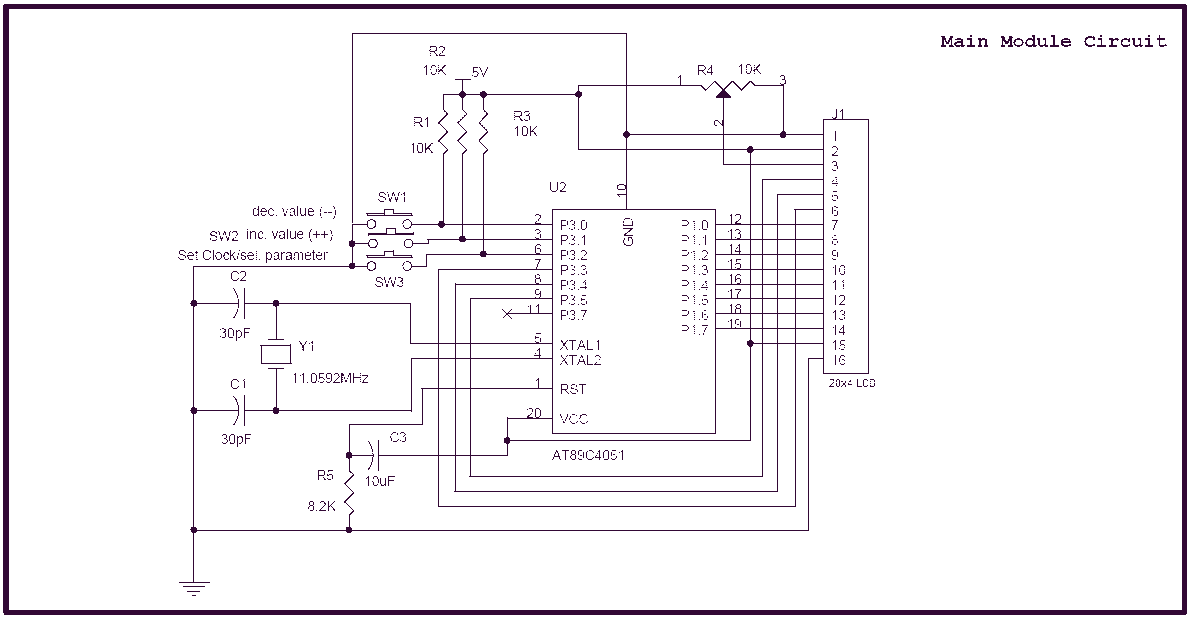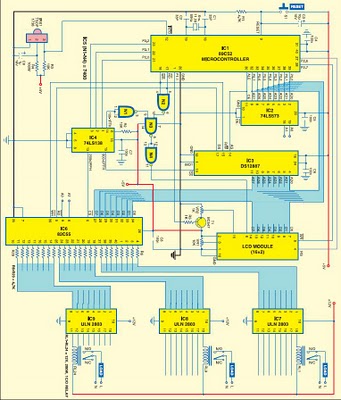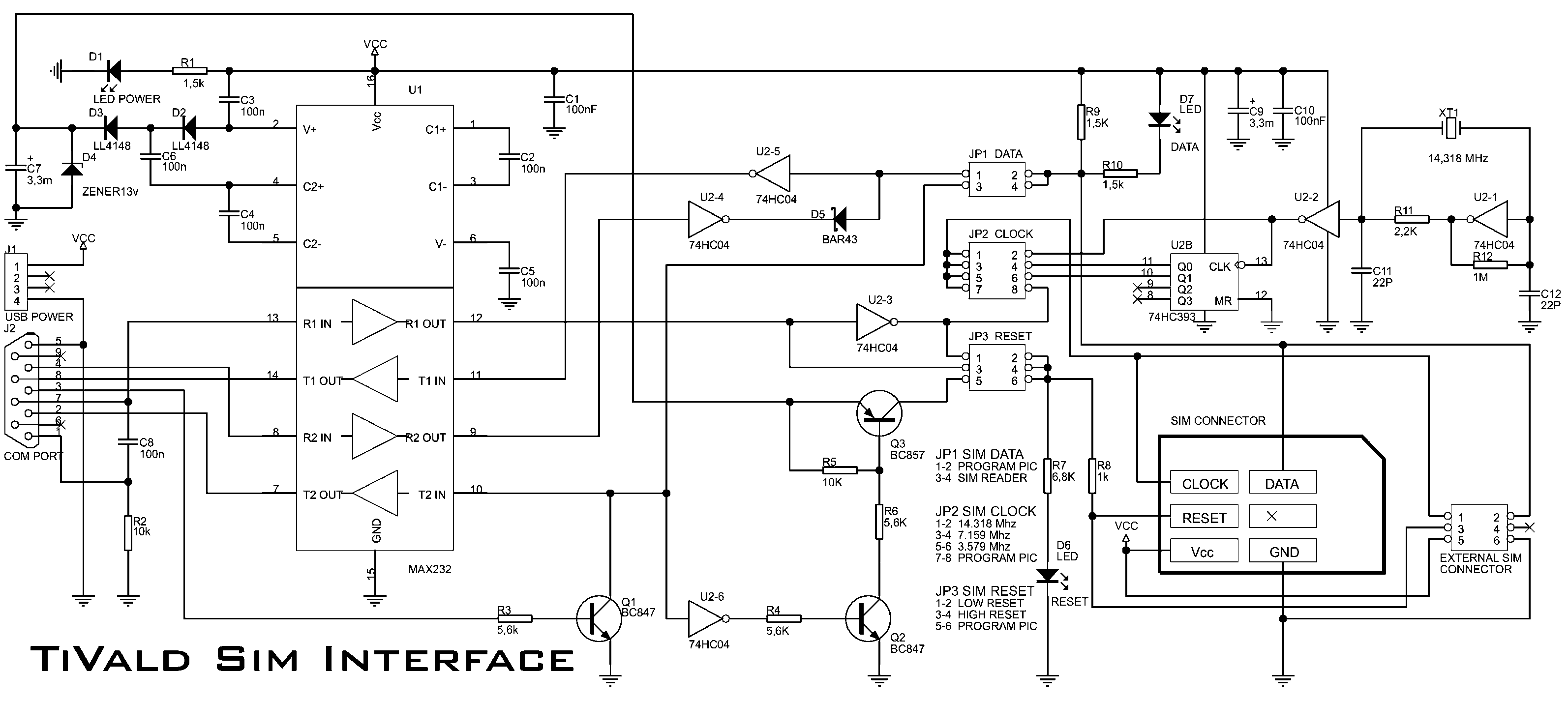
AT89C4051 as RTC

It's a digital clock which makes use of AT89C4051 to work as a real-time clock. Port 1 of the controller (AT89C4051) is used as the data lines for the LCD (starting from pin 7 to pin 14 of LCD). As you can see, there is not much change in the hardware except the LCD; here I am using a 20 x 4 lines LCD display. More: In figure 3, as you can see, the digits are bigger than the normal size. For this purpose, I am making use of the CGRAM of the LCD, which gives the flexibility to the user to define user-defined characters.
The digital clock circuit utilizes the AT89C4051 microcontroller as the core component for real-time clock functionality. The AT89C4051 is an 8-bit microcontroller that is part of the MCS-51 family, featuring a 4KB flash memory, 128 bytes of RAM, and 32 I/O lines. In this design, Port 1 of the AT89C4051 is dedicated to interfacing with a 20x4 LCD display, where data is transmitted to the display for visualization of the time.
The LCD operates in 4-bit mode, allowing it to use only four data lines from Port 1, thus conserving I/O resources. The pins used for the LCD connection are typically defined as follows: RS (Register Select), RW (Read/Write), and E (Enable) are connected to specific control lines on the microcontroller. The remaining data pins, D4 to D7, are connected to Port 1 of the AT89C4051, starting from pin 7 to pin 14 of the LCD.
To enhance the display, the design incorporates the use of Character Generator RAM (CGRAM) within the LCD controller. This feature enables the creation of custom characters, which is particularly useful for displaying larger digits or unique symbols that are not available in the standard character set. The process of defining these custom characters involves writing specific patterns to the CGRAM, allowing the user to customize the appearance of the displayed digits.
The clock function is implemented through a timing mechanism, typically using a crystal oscillator connected to the microcontroller, which provides the necessary timing intervals for accurate timekeeping. The software running on the AT89C4051 is responsible for managing the timing, updating the LCD display, and handling user inputs if any buttons are included for setting the time.
Overall, this digital clock circuit effectively combines the capabilities of the AT89C4051 microcontroller with a flexible LCD display to create a user-friendly timekeeping device that can be customized to display information in a visually appealing manner.Its a digial clock which make use of AT89C4051 to work as a Real time clock. Port 1 of the controller (AT89C4051) is used as the data lines for the LCD (starting from pin 7- pin14 of LCD). As you can see there is not much change in the hardware except the LCD, here i am using a 20 x 4 lines LCD display.
In figure 3 as you can see the digits are bigger than the normal size. For this purpose i`m maiking use of the CGRAM of the LCD, which gives the flexibility to the user to define user defined characters. so to create a character we first need to get 🔗 External reference
The digital clock circuit utilizes the AT89C4051 microcontroller as the core component for real-time clock functionality. The AT89C4051 is an 8-bit microcontroller that is part of the MCS-51 family, featuring a 4KB flash memory, 128 bytes of RAM, and 32 I/O lines. In this design, Port 1 of the AT89C4051 is dedicated to interfacing with a 20x4 LCD display, where data is transmitted to the display for visualization of the time.
The LCD operates in 4-bit mode, allowing it to use only four data lines from Port 1, thus conserving I/O resources. The pins used for the LCD connection are typically defined as follows: RS (Register Select), RW (Read/Write), and E (Enable) are connected to specific control lines on the microcontroller. The remaining data pins, D4 to D7, are connected to Port 1 of the AT89C4051, starting from pin 7 to pin 14 of the LCD.
To enhance the display, the design incorporates the use of Character Generator RAM (CGRAM) within the LCD controller. This feature enables the creation of custom characters, which is particularly useful for displaying larger digits or unique symbols that are not available in the standard character set. The process of defining these custom characters involves writing specific patterns to the CGRAM, allowing the user to customize the appearance of the displayed digits.
The clock function is implemented through a timing mechanism, typically using a crystal oscillator connected to the microcontroller, which provides the necessary timing intervals for accurate timekeeping. The software running on the AT89C4051 is responsible for managing the timing, updating the LCD display, and handling user inputs if any buttons are included for setting the time.
Overall, this digital clock circuit effectively combines the capabilities of the AT89C4051 microcontroller with a flexible LCD display to create a user-friendly timekeeping device that can be customized to display information in a visually appealing manner.Its a digial clock which make use of AT89C4051 to work as a Real time clock. Port 1 of the controller (AT89C4051) is used as the data lines for the LCD (starting from pin 7- pin14 of LCD). As you can see there is not much change in the hardware except the LCD, here i am using a 20 x 4 lines LCD display.
In figure 3 as you can see the digits are bigger than the normal size. For this purpose i`m maiking use of the CGRAM of the LCD, which gives the flexibility to the user to define user defined characters. so to create a character we first need to get 🔗 External reference





